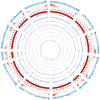Comprehensive Characterization of Simple Sequence Repeats in Eggplant (Solanum melongena L.) Genome and Construction of a Web Resource
- PMID: 29643862
- PMCID: PMC5883146
- DOI: 10.3389/fpls.2018.00401
Comprehensive Characterization of Simple Sequence Repeats in Eggplant (Solanum melongena L.) Genome and Construction of a Web Resource
Abstract
We have characterized the simple sequence repeat (SSR) markers of the eggplant (Solanum melongena) using a recent high quality sequence of its whole genome. We found nearly 133,000 perfect SSRs, a density of 125.5 SSRs/Mbp, and also about 178,400 imperfect SSRs. Of the perfect SSRs, 15.6% were complex, with two stretches of repeats separated by an intervening block of <100 nt. Di- and trinucleotide SSRs accounted, respectively, for 43 and 37% of the total. The SSRs were classified according to their number of repeats and overall length, and were assigned to their linkage group. We found 2,449 of the perfect SSRs in 2,086 genes, with an overall density of 18.5 SSRs/Mbp across the gene space; 3,524 imperfect SSRs were present in 2,924 genes at a density of 26.7 SSRs/Mbp. Putative functions were assigned via ontology to genes containing at least one SSR. Using this data we developed an "Eggplant Microsatellite DataBase" (EgMiDB) which permits identification of SSR markers in terms of their location on the genome, type of repeat (perfect vs. imperfect), motif type, sequence, repeat number and genomic/gene context. It also suggests forward and reverse primers. We employed an in silico PCR analysis to validate these SSR markers, using as templates two CDS sets and three assembled transcriptomes obtained from diverse eggplant accessions.
Keywords: SSR; Solanum melongena; database; eggplant; genome; microsatellite.
Figures









References
LinkOut - more resources
Full Text Sources
Other Literature Sources
Research Materials
Miscellaneous

